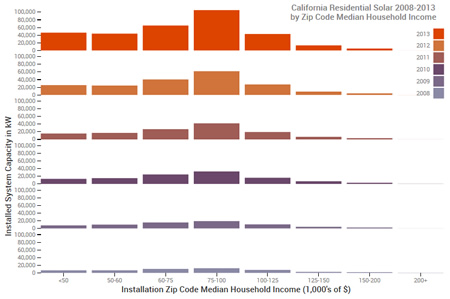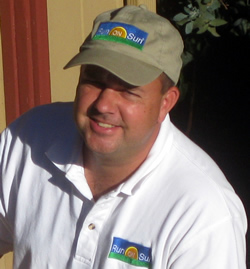Welcome to the
Run on Sun Monthly Newsletter

In this Issue: |
August, 2014
Volume: 5 Issue: 8
Do Pro-Solar Policies Hurt the Poor?
So far most utilities appear to be holding out for option B. Of course the fossil fuel industry in general, and utilities in particular, are not sympathetic entities with the public so they need a different angle, a better hook if they are going to convince people to abandon solar. Cue the Koch brothers funded Americans for Prosperity (AFP), and their faux concern for the poor. In an article titled "How State Solar Policies Hurt America's Poor," (h/t Solar Wakeup) AFP Policy Analyst Justin Sykes advances the canard that net metering polices harm poor consumers. In a piece rife with inaccuracies, Sykes makes a number of misleading statements. Try this one:
Sorry, but the data simply doesn't support those statements. Let's start with the assertion that solar households have much higher median incomes that non-solar households. In every year, whether purchased or leased, the majority of solar was in zip codes where the median household income was at or below $75,000, with only a relative handful in neighborhoods above $125,000. Indeed, there were more installations in zip codes with a median income of less than $50,000 than there were in zip codes with a median income above $125,000! Now to be sure, zip code averages are not the same thing as actual customer income, but actual household income of solar customers is not a publicly available piece of data, so this is the best proxy available (and presumably the same proxy available to the likes of AFP's Mr. Sykes.) And while we are debunking things, let's take a look at the statistic about how "low-income households spend an estimated 37 percent of their income on household energy bills." Seriously? The link supporting that stat takes you to an article that provides no support for the number. But more to the point, how could that number even be possible? According to the U.S. Department of Health & Human Services, the 2014 Poverty Guideline for a family of four is $23,850, of which 37% would be $8,824.50, which works out to a monthly energy bill of $735! Once again, the data tells a very different tale. According to the U.S. Energy Information Administration, the average U.S. household spends roughly $2,000 per year on all household energy (excluding transportation) and that figure is across all households, not just low income households. (In California, that average is below $1,500 thanks to energy efficiency measures adopted in the state.) This is how the battle against solar is being fought: with misleading claims and made-up statistics. But here is the reality: as solar gets cheaper, and innovative programs like solar loans and HERO PACE financing become widely available, more and more people will realize that they can afford solar and will jump at the chance, rich and poor alike. |
“There were more installations in zip codes with a median income of less than $50,000 than there were in zip codes with a median income above $125,000!”
Get your copy of
Commercial Solar:
Step-by-Step
from
Run on Sun
Founder & CEO
Jim Jenal

Now available on Amazon.com
in both
Print & Kindle versions.
Bonus - Buy the Print version…
Get the
Kindle version for Free!
Commercial Solar:
Step-by-Step
from Run on Sun
Founder & CEO
Jim Jenal

Now available on Amazon.com
in both Print & Kindle versions.
Get the Kindle version for Free!
Help Us Spread the News!





SolarWorld Announces Major RecallWe have just learned that solar panel manufacturer SolarWorld has announced a recall involving 1.3 million solar panels sold in the U.S. since June 2011. According to the Notice filed with the Consumer Products Safety Commission:
Behind the HeadlineSo what exactly is the issue here? All metal components of a solar power system—such as the frames of the solar panels and the rails to which they are attached—are supposed to be grounded. There are many ways that can be done, but one common method is to attach a copper lug to the panel frame and run a copper grounding wire from lug to lug and ultimately to ground. The problem arises from the fact that copper grounding lugs come in two varieties: bare copper and "tinned" copper, that is copper with a coating of tin.
If the installer used a bare copper lug, it could cause corrosion to form between the panel frame and the lug. That corrosion could prevent the ground from being effective, which could result in the potential problems highlighted in the CPSC notice. In other words, while this is a potential problem and systems should be inspected to insure that the proper, "tinned" lug was used, the recall does not involve the safety of the solar panels themselves. Moreover, the fix, if required, is straightforward (even if potentially time consuming): simply replace the improper lugs with proper ones. Who Used the Panels?While the recall notice refers to 1.3 million panels in the U.S., we wanted to get a sense of how many of these panels have been installed in California, and, more specifically, in the Run on Sun service area. To get a handle on that we turned to two familiar data sources: CSI data (showing installs in SCE, PG&E and SDG&E territories) and LADWP data. Given that LADWP requires the use of grounding lugs (as opposed to WEEBs), there is an even higher probability that SolarWorld systems in LADWP territory used a grounding lug. CSI DataThe CSI data shows just how widespread this issue could be. More than half a million SolarWorld panels have been installed in CSI territories, accounting for over 6,500 different installations, installed by more than 500 different companies! How many of those companies are still in business is anybody's guess. In SCE territory alone, 186,000 SolarWorld panels were installed at 3,125 different projects, by nearly 300 different companies. The installers with by far the greatest number of SolarWorld panels installed are Shorebreak Energy Developers (43,242 panels installed at 46 different projects) and Chevron Energy Solutions (20,464 panels at 15 projects). In terms of having the greatest number of projects, six companies have 100 or more projects, and the winners there are: A1 Solar Power, Inc. (217 projects), Titan Construction and Solar (202), Natural Energy (186), Contact Electric (174), Future Energy Corporation (124) and TLP Electric Integrations (103). LADWP DataThe LADWP data is, not surprisingly, somewhat more opaque. For example, they do not track how many solar panels are installed on a given project so we cannot determine the total number of SolarWorld panels that have been installed. We do know that there are some 759 projects overall where SolarWorld panels were used, and more than 100 different installers were involved. Three of those installers were responsible for fifty or more projects, they are: A1 Solar Power, Inc. (120 projects), Sungate Energy Solutions (76) and American Solar Solutions (67). Looks like the folks at A1 Solar Power are going to be busy! What to Do?If you are the owner of a SolarWorld installation, you will want to contact your installer and see what they are willing to do. At a minimum, they should be willing to come out to your site, free of cost, and verify that the proper lugs were used. Even if it were the company's policy to always use "tinned" lugs, a system owner should not rely on those assurances since install crews have been known to substitute whatever is available at the local hardware store in order to complete the project and move on to the next. If your installer is no longer in business, or is unwilling to come out and verify that your system is safe, you should contact SolarWorld themselves directly. They have established a toll-free number to call: 877-360-1787, M-F from 9 a.m. to 6 p.m. |
Brad Banta - Thanks and FarewellIt is with considerable sadness but much gratitude that we announce the departure from Run on Sun of co-founder, Brad Banta. (We are consoled by the knowledge that Brad has agreed to remain connected by way of our Advisory Board, so we will still have access, from time-to-time, to his sage insights.)
It was an omen! We founded Run on Sun two months later and over the years we settled into our fitting roles: I as CEO and the public face of the company, Brad behind the scenes as CFO, keeping us afloat even while the economy tanked and many others folded shop. Today, with Run on Sun sporting its biggest pipeline of projects ever, Brad is moving on to new challenges. To say that we wish him well is a massive understatement. Truth is, we never could have done this without his help. So thanks, Brad, for everything. |





